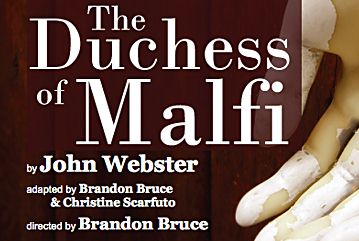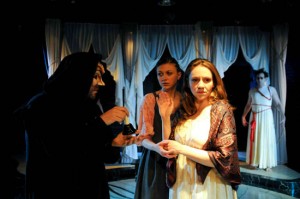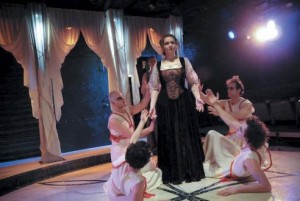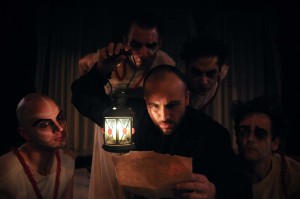TOO MANY THEATER INGREDIENTS
SPOIL THE BROTH
If there were a Joseph Jefferson Award simply for risk-taking in the theatre, Brandon Bruce would most assuredly win for his direction of John Webster’s Jacobean tragedy, The Duchess of Malfi. Mr. Bruce has assembled a savvy design team and has employed numerous theatrical styles to tell the tale at Strawdog Theatre. While Stage and Cinema sincerely bestows Mr. Bruce with an “A for Effort†award, the hodgepodge of old-school, experimental theater techniques ultimately add confusion to an already tricky play – one which is made even more inaccessible by the truncated, sped-up adaptation by Mr. Bruce (with Christine Scarfuto). All of the latter would have been acceptable, however, had the uneven acting not become the dirt which asphyxiated the story’s fire.
Webster’s macabre English Renaissance opus is continually toyed with in countless adaptations, but the main story thrust is this: A widowed Duchess (the resplendent Justine C. Turner) is forbidden by her two brothers to remarry; one is her trigger-tempered, fanatic, incestuous twin Ferdinand (an annoyingly manic Stephen Dunn); the other is an unethical Catholic Cardinal named…The Cardinal (a classically strong Christopher M. Walsh). The brothers want all riches to stay in the family, and the Duchess doesn’t want to make waves, so she marries her beloved steward Antonio (the adequate Stephen Dunn) in a secret ceremony, later bearing three of his children. And how does the Duchess keep this secret? Through the aid of her waiting-woman Cariola (Lindsey Dorcus), who has witnessed the wedding and delivered her children. But how this personal servant manages to keep secret such a high-profile secret is the best-kept secret of the evening. Equally odd is the unexplained nature of the Duchess’s attachment to Antonio. I’ll stop there, but my list of bemusements regarding the script’s adaptation is lengthy.
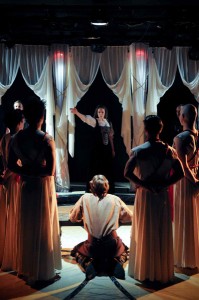 The Duchess may be the obvious protagonist, but the central figure is clearly Bozola (Joshua Davis), a spy and murderer who undergoes a change of heart after his evil doings. It’s a deliciously complex character who blurs the line between tragic villain, protagonist, and the stock cynical malcontent of Jacobean drama.
The Duchess may be the obvious protagonist, but the central figure is clearly Bozola (Joshua Davis), a spy and murderer who undergoes a change of heart after his evil doings. It’s a deliciously complex character who blurs the line between tragic villain, protagonist, and the stock cynical malcontent of Jacobean drama.
The adapted story is convoluted enough, but very little about this production or the staging elucidated the text. In fact, this reviewer was downright addlepated. All of the secondary characters were assigned to a five-member Greek Chorus with togas and painted white faces, but the main characters were costumed in Elizabethan garb (excellent costumes and make-up by Joanna Melville and Aly Renee Amidei, respectively). The clashing styles were one thing, but when the chorus began one scene with a circular ass-slapping ritual, it downgraded them to some kind of incomprehensible performance piece. Sure, the staging was cool, but the meaning was beyond my understanding, even as the knees of my theatergoing companion began bouncing in subconscious delight.
I suspect the ass-slapping was a form of Butoh, a sort of indefinable physicality which began in Japan after WWII, but the evening’s international stylistic mish-mash was also reminiscent of SITI, founded in 1992 by Anne Bogart and Tadashi Suzuki to revitalize contemporary theater. Throw in a little Jerzy Grotowski-like investigational theater methods, in which actors’ represent everything from candlelight to furniture, and we end up with a theatrical bowl of rocks that I suspect Bruce had hoped would be a melting pot. Even so, Ms. Turner as the Duchess and Mr. Walsh as the Cardinal both resoundingly elevated themselves above the structural incoherency.
Admittedly, the mélange of styles did coalesce towards the end of Act IV and into the death-soaked fifth act. Joe Schermoly’s white-draped set, Jordan Kardasz’s inventive lighting and Mike Przygoda’s eerie sound design really came together towards Webster’s tragic ending – which makes Hamlet look like Sesame Street – with its strangulating, neck-cracking, poison-Bible-licking, disemboweling, and infanticidal murders. As the impaling began, accidental or otherwise, black ropes were utilized to represent the victims’ guts; once the chorus pulled them tautly about the playing area, it created a chilling stage picture of a black spider’s web. But as for the production in its entirety, oh, what a tangled web was weaved.
photos by Chris Ocken
The Duchess of Malfi
Strawdog Theatre Company
3829 N. Broadway St
Thurs-Sat at 8; Sun at 4
ends on ay 26, 2012
for tickets, call 866.811.4111 or visit Strawdog
